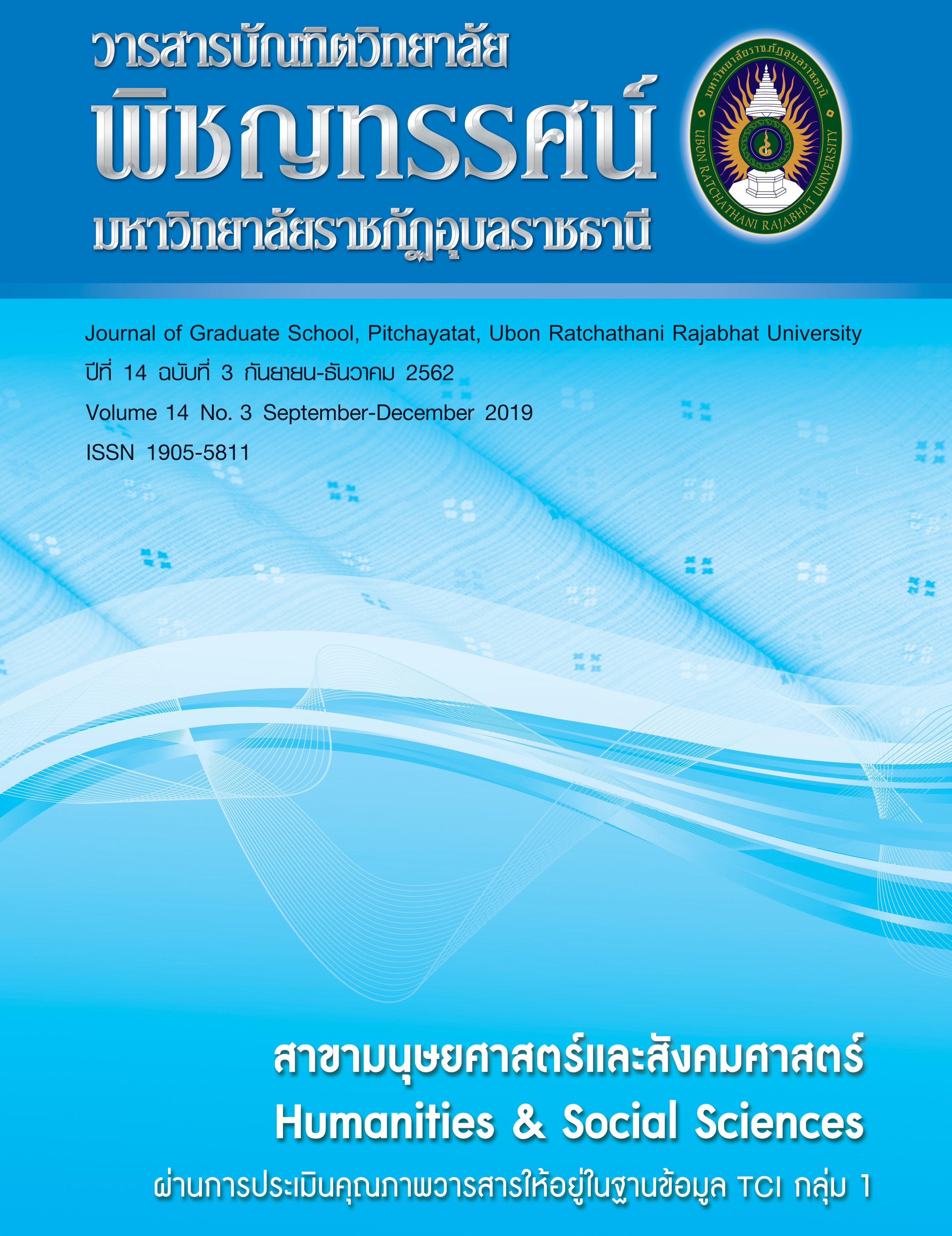การพัฒนาบทเรียนบนเว็บโดยใช้การเรียนรู้แบบใช้คำถามที่ส่งเสริมการคิดวิเคราะห์ของนักเรียน ชั้นมัธยมศึกษาปีที่ 1
คำสำคัญ:
การพัฒนาบทเรียนบนเว็บ, การเรียนรู้แบบใช้คำถามบทคัดย่อ
การวิจัยในครั้งนี้ มีวัตถุประสงค์เพื่อ 1) พัฒนาบทเรียนบนเว็บโดยใช้การเรียนรู้แบบใช้คำถามที่ส่งเสริมการคิดวิเคราะห์ของนักเรียนชั้นมัธยมศึกษาปีที่ 1 2) หาค่าดัชนีประสิทธิผลของบทเรียนบนเว็บ ด้วยเทคนิคการเรียนรู้แบบใช้คำถามที่ส่งเสริมการคิดวิเคราะห์ ของนักเรียนชั้นมัธยมศึกษาปีที่ 1 ที่ได้พัฒนาขึ้น 3) เปรียบเทียบความสามารถในการคิดวิเคราะห์ของนักเรียนชั้นมัธยมศึกษาปีที่ 1 ที่เรียนด้วยบทเรียนบนเว็บ โดยใช้การเรียนรู้แบบใช้คำถามที่ส่งเสริมการคิดวิเคราะห์ และการเรียน แบบปกติ 4) เปรียบเทียบผลสัมฤทธิ์ทางการเรียนของนักเรียนชั้นมัธยมศึกษาปีที่ 1 ที่เรียนด้วยบทเรียนบนเว็บ โดยใช้การเรียนรู้แบบใช้คำถามที่ส่งเสริมการคิดวิเคราะห์ และการเรียนแบบปกติ 5) ศึกษาความพึงพอใจของนักเรียนชั้นมัธยมศึกษาปีที่ 1 ที่เรียนด้วยบทเรียนบนเว็บโดยใช้การเรียนรู้แบบใช้คำถามที่ส่งเสริมการคิดวิเคราะห์ ตัวอย่างได้มาจากการสุ่มตัวอย่างแบบหลายขั้นตอน เครื่องมือที่ใช้ในการวิจัย ได้แก่ บทเรียนบนเว็บการเรียนรู้แบบใช้คำถาม เรื่อง แหล่งมรดกโลกในเอเชียตะวันออกเฉียงใต้ แบบวัดผลสัมฤทธิ์ทางการเรียน แบบวัดการคิดวิเคราะห์ และแบบประเมินความพึงพอใจ สถิติที่ใช้ในการวิเคราะห์ข้อมูลได้แก่ ร้อยละ ค่าเฉลี่ย ส่วนเบี่ยงเบนมาตรฐาน และการทดสอบทีแบบสองกลุ่มอิสระ
ผลการวิจัยปรากฏดังนี้
- บทเรียนบนเว็บโดยใช้การเรียนรู้แบบใช้คำถามที่ส่งเสริมการคิดวิเคราะห์ ของนักเรียนชั้นมัธยมศึกษาปีที่ 1 ที่มีระดับคุณภาพ ดีมาก โดยด้านที่ 1 ด้านโปรแกรมคอมพิวเตอร์และสื่อ มีค่าเฉลี่ยโดยรวม 4.23 และด้านที่ 2 ด้านเนื้อหา มีค่าเฉลี่ยโดยรวม 4.39 โดยทั้ง 2 ด้าน มีระดับคุณภาพ ดีมาก
- ดัชนีประสิทธิผลของบทเรียนบนเว็บด้วยเทคนิคการเรียนรู้แบบใช้คำถามที่ส่งเสริมการคิดวิเคราะห์ ของนักเรียนชั้นมัธยมศึกษาปีที่ 1 มีค่าดัชนีประสิทธิผลเท่ากับ 0.6137
- 3. การเปรียบเทียบการคิดวิเคราะห์ของนักเรียนที่เรียนด้วยบทเรียนบนเว็บ โดยใช้การเรียนรู้แบบใช้คำถาม ของนักเรียนชั้นมัธยมศึกษาปีที่ 1 และการเรียนแบบปกติ แตกต่างกันอย่างมีนัยสำคัญทางสถิติที่ระดับ .05
- 4. การเปรียบเทียบผลสัมฤทธิ์ทางการเรียนของนักเรียนที่เรียนบทเรียนบนเว็บ โดยใช้การเรียนรู้แบบใช้คำถามที่ส่งเสริมการคิดวิเคราะห์ ของนักเรียนชั้นมัธยมศึกษาปีที่ 1 และการเรียนแบบปกติแตกต่างกันอย่างมีนัยสำคัญทางสถิติที่ระดับ .05
- 5. นักเรียนมีความพึงพอใจต่อการเรียนด้วยบทเรียนบนเว็บ โดยใช้การเรียนรู้แบบใช้คำถาม ที่ส่งเสริมการคิดวิเคราะห์ ของนักเรียนชั้นมัธยมศึกษาปีที่ 1 โดยรวมอยู่ในระดับมากที่สุด (=4.66)
เอกสารอ้างอิง
กิตติยา อุดน้อย. การเปรียบเทียบผลสัมฤทธิ์ทางการเรียนและการคิดวิเคราะห์ของนักเรียนชั้นมัธยมศึกษาปีที่ 3 ที่เรียนด้วยบทเรียนแบบเว็บเควสท์กับบทเรียนบนเครือข่ายแบบสืบเสาะ. วิทยานิพนธ์การศึกษามหาบัณฑิต มหาวิทยาลัยมหาสารคาม, 2553.
คณะกรรมการการศึกษาแห่งชาติ, สำนักงาน.พระราชบัญญัติการศึกษาแห่งชาติ พ.ศ. 2542. กรุงเทพฯ: สำนักงาน, 2542.
ไชยยศ เรืองสุวรรณ. การออกแบบพัฒนาโปรแกรมบทเรียนและบทเรียนบนเว็บ. มหาสารคาม: มหาวิทยาลัยมหาสารคาม, 2553.
ไชยยศ เรืองสุวรรณ. การพัฒนาคอร์สแวร์และบทเรียนบนเครือข่าย (Courseware & Web-based Instruction Development). พิมพ์ครั้งที่ 13. มหาสารคาม: มหาวิทยาลัยมหาสารคาม, 2552.
ญาณิน สุดสวนสี. ผลการเรียนด้วยบทเรียนบนเว็บกับการเรียนแบบปกติที่มีต่อผลสัมฤทธิ์ทางการ เรียนภาษาอังกฤษด้านการอ่านเพื่อการสื่อสารและการคิดวิเคราะห์ของนักเรียนชั้นมัธยมศึกษาปีที่4. วิทยานิพนธ์การศึกษามหาบัณฑิต มหาวิทยาลัยมหาสารคาม, 2553.
ทิศนา แขมมณี. รูปแบบการเรียนการสอนทางเลือกที่หลากหลาย. พิมพ์ครั้งที่ 3. กรุงเทพฯ: จุฬาลงกรณ์มหาวิทยาลัย, 2548.
เผชิญ กิจระการ. การวิเคราะห์ประสิทธิภาพสื่อและเทคโนโลยีเพื่อการศึกษา. วารสารการวัดผลการศึกษามหาวิทยาลัยมหาสารคาม. 7,7 (กรกฎาคม 2544): 44-51.
โพธิแสนวิทยา, โรงเรียน.รายงานการสอบคุณภาพการศึกษาขั้นพื้นฐานเพื่อการประกันคุณภาพผู้เรียน. สกลนคร: งานวิชาการ, 2558.
มลธิดา ขบวนงาม. การพัฒนาบทเรียนบนเว็บตามแนวทฤษฎีการเรียนรู้เพื่อสร้างสรรค์ด้วยปัญญาและบทเรียนบนเว็บแบบ KWL PLUS เพื่อส่งเสริมความสามารถการคิดวิเคราะห์เรื่องการอ่านสารในชีวิตประจำวันและงานอาชีพของนักเรียนระดับประกาศนียบัตรวิชาชีพชั้นปีที่ 1. วิทยานิพนธ์การศึกษามหาบัณฑิต มหาวิทยาลัยมหาสารคาม, 2558.
วรัท พฤกษากุลนันท์. การเรียนการสอนผ่านเว็บ. (ออนไลน์) 2558 (อ้างเมื่อ 18 ตุลาคม 2560).จาก https://www.kroobannok.com/133
ศึกษาธิการ, กระทรวง. หลักสูตรแกนกลางการศึกษาขั้นพื้นฐาน พุทธศักราช 2551. กรุงเทพฯ: โรงพิมพ์คุรุสดาลาดพร้าว, 2551.
สยาม นามสน. การเปรียบเทียบผลการเรียนรู้ด้วยบทเรียนบนเว็บกับการเรียนแบบปกติเรื่องการสร้างเว็บเพจของนักเรียนชั้นมัธยมศึกษา
ปีที่ 5. วิทยานิพนธ์การศึกษามหาบัณฑิต มหาวิทยาลัยมหาสารคาม, 2557.
สุชัญญ์ พฤกษวัลต์. ผลของการเรียนด้วยบทเรียนผ่านเครือข่ายอินเทอร์เน็ต หน่อยศิลปะสมัยใหม่ตอนต้นโดยใช้กิจกรรมการจัดการความรู้ในกระบวนการเรียนการสอน. วิทยานิพนธ์การศึกษามหาบัณฑิตมหาวิทยาลัยสงขลานครินทร์, 2554.
สุวิทย์ มูลคำ และอรทัย มูลคำ. 21วิธีการจัดการเรียนรู้: เพื่อพัฒนากระบวนการคิด. พิมพ์ครั้งที่ 7. กรุงเทพฯ: ภาพพิมพ์, 2551.
อารีรัตน์ สังขะทิพย์. การเปรียบเทียบผลการเรียนรู้ของนักเรียนที่เรียนด้วยบทเรียนบนเว็บแบบกลุ่มร่วมมือโดยใช้เทคนิค TGT กับการเรียนแบบปกติเรื่องการสร้างเว็บเพจ ชั้นมัธยมศึกษาปีที่ 3. วิทยานิพนธ์การศึกษามหาบัณฑิต มหาวิทยาลัยมหาสารคาม, 2556.
อิงอร บุตรศรีผา. การเปรียบเทียบผลการเรียนรู้ด้วยบทเรียนบนเว็บโดยใช้การเรียนแบบร่วมมือตามเทคนิค STAD และเทคนิค LT เรื่องการสืบค้นสารสนเทศของนิสิตระดับปริญญาตรี มหาวิทยาลัยมหาจุฬาลงกรณราชวิทยาลัย วิทยาเขตหนองคาย. วิทยานิพนธ์การศึกษามหาบัณฑิต มหาวิทยาลัยมหาสารคาม, 2556.
ดาวน์โหลด
เผยแพร่แล้ว
รูปแบบการอ้างอิง
ฉบับ
ประเภทบทความ
สัญญาอนุญาต
บทความทุกเรื่องได้รับการตรวจความถูกต้องทางวิชาการโดยผู้ทรงคุณวุฒิภายนอกอย่างน้อย 3 คน ความคิดเห็นในวารสารพิชญทรรศน์เป็นความคิดเห็นของผู้นิพนธ์มิใช่ความคิดเห็นของผู้จัดทำ จึงมิใช่ความรับผิดชอบของวารสารพิชญทรรศน์ และบทความในวารสารพิชญทรรศน์สงวนสิทธิ์ตามกฎหมายไทย การจะนำไปเผยแพร่ต้องได้รับอนุญาตเป็นลายลักษณ์อักษรจากกองบรรณาธิการ





